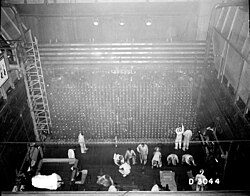
Back Manhattan-projek Afrikaans مشروع مانهاتن Arabic Proyeutu Manhattan AST Manhetten layihəsi Azerbaijani Proyék Manhattan BAN Манхэтэнскі праект Byelorussian Проект „Манхатън“ Bulgarian ম্যানহাটন প্রকল্প Bengali/Bangla Raktres Manhattan Breton Projekt "Manhattan" BS
| Manhattan District | |
|---|---|
| |
| Active | 1942–1946 |
| Disbanded | 15 August 1947 |
| Country |
|
| Branch | U.S. Army Corps of Engineers |
| Garrison/HQ | Oak Ridge, Tennessee, U.S. |
| Anniversaries | 13 August 1942 |
| Engagements | |
| Commanders | |
| Notable commanders | |
| Insignia | |
| Manhattan District shoulder sleeve insignia |  |
The Manhattan Project was a research and development program undertaken during World War II to produce the first nuclear weapons. It was led by the United States in collaboration with the United Kingdom and Canada.
From 1942 to 1946, the project was directed by Major General Leslie Groves of the U.S. Army Corps of Engineers. Nuclear physicist J. Robert Oppenheimer was the director of the Los Alamos Laboratory that designed the bombs. The Army program was designated the Manhattan District, as its first headquarters were in Manhattan; the name gradually superseded the official codename, Development of Substitute Materials, for the entire project. The project absorbed its earlier British counterpart, Tube Alloys, and subsumed the program from the American civilian Office of Scientific Research and Development.
The Manhattan Project employed nearly 130,000 people at its peak and cost nearly US$2 billion (equivalent to about $27 billion in 2023),[1] over 80 percent of which was for building and operating the plants that produced the fissile material which acted as fuel for the bombs. Enriched uranium was produced at Clinton Engineer Works in Tennessee. Plutonium was produced in the world's first industrial-scale nuclear reactors, built at Hanford Site in Washington. Each of these sites were supported by dozens of other facilities across the US, the UK, and Canada. Initially, it was assumed that both fuels could be used in a relatively simple atomic bomb design known as the gun-type design. When it was discovered that this design was incompatible for use with plutonium, an intense development program led to the invention of the implosion design. The work on weapons design was performed at the Los Alamos Laboratory in New Mexico, and resulted in two weapons designs that were used during the war: Little Boy (enriched uranium gun-type) and Fat Man (plutonium implosion).
The first nuclear device ever detonated was an implosion-type bomb during the Trinity test, conducted at White Sands Proving Ground in New Mexico on 16 July 1945. The project also was responsible for developing the specific means of delivering the weapons onto military targets, and were responsible for the use of the Little Boy and Fat Man bombs in the atomic bombings of Hiroshima and Nagasaki in August 1945.
The project was also charged with gathering intelligence on the German nuclear weapon project. Through Operation Alsos, Manhattan Project personnel served in Europe, sometimes behind enemy lines, where they gathered nuclear materials and documents and rounded up German scientists. Despite the Manhattan Project's own emphasis on security, Soviet atomic spies penetrated the program.
In the immediate postwar years, the Manhattan Project conducted weapons testing at Bikini Atoll as part of Operation Crossroads, developed new weapons, promoted the development of the network of national laboratories, supported medical research into radiology, and laid the foundations for the nuclear navy. It maintained control over American atomic weapons research and production until the formation of the United States Atomic Energy Commission (AEC) in January 1947.
- ^ Johnston, Louis; Williamson, Samuel H. (2023). "What Was the U.S. GDP Then?". MeasuringWorth. Retrieved 30 November 2023. United States Gross Domestic Product deflator figures follow the MeasuringWorth series.
© MMXXIII Rich X Search. We shall prevail. All rights reserved. Rich X Search






